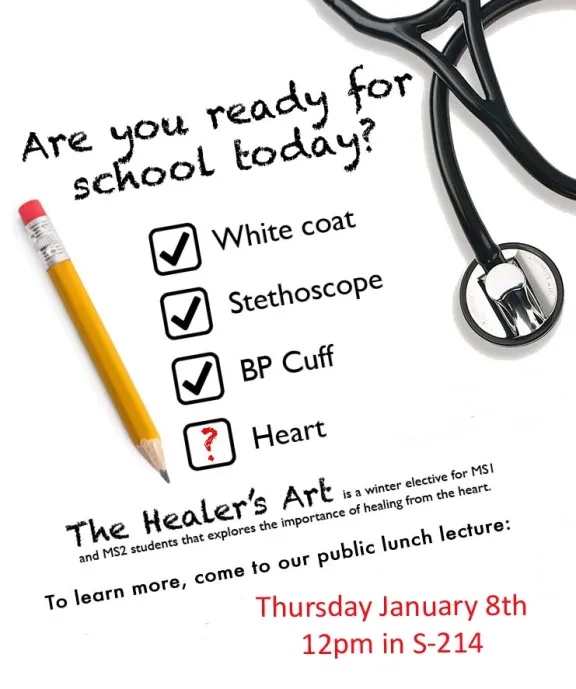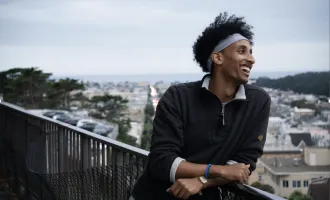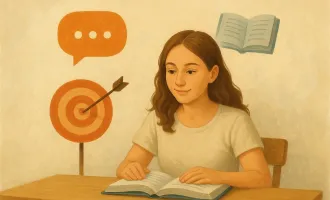
The Healer's Art Offered at UCSF for the 24th Year
“Time out,” my Foundations of Patient Care (FPC) facilitator interjected. Mrs. Henderson, the standardized patient, wilted: her shoulders relaxed, eyes closed, head tilted downward.
Simulated interview paused and swimming in self-doubt, I gathered advice from the observing classmates and faculty facilitators. As I struggled to find the right questions, they reminded me to “take off my doctor hat” and consider how to proceed as “myself,” as if in a conversation outside the simulated exam room. The odd and unintentional disconnect between the practice of medicine and my own personality had been automatic.
The rift runs deep. Formally inducted into the profession at their White Coat Ceremony, medical students vow to embody the highest ideals, but the sheer quantity of information in the years that follow--compounded by stress and emotional exhaustion--overwhelm their commitment to compassion. Nearly half of students reach burnout during medical school; stories of physician regret and suicide abound. Something is wrong, something missing in the long journey of medical training.
Dr. Rachel Naomi Remen, Clinical Professor of Family and Community Medicine at UCSF, identified this unmet need 24 years ago and responded with The Healer’s Art. The annual winter elective was founded at UCSF and is now offered at more than 80 medical schools across the world. Its curriculum helps thousands of students understand how to bring themselves to their profession and find meaning in medicine.
“The course helps you remain mindful in medical school and training,” shared Dr. Laura Schoenherr, UCSF Internal Medicine intern and former Healer’s Art student. “First and second year can be much more intellectual, and the humanistic side of medicine is not the primary focus. Healer’s Art can really prime you for the clinical years and the emotional experience that is medicine.”
Associate Professor of Family Community Medicine at UCSF, Dr. Steven Bromer has led a Healer’s Art small group for decades. He emphasizes that the course provides “permission [for students] to bring who they really are into their work and their training and lets them know it’s okay to experience things in other ways… [It is based on] the discovery model that is not so much about the content but the space to share who you are. It’s a chance to get to know people, listen to their stories, hear where they struggle. It’s a chance to remember the most important part of medicine.”
Over five three-hour sessions, the course creates a unique environment that reshapes how students understand one another. Most sessions begin with a seed talk for all students, but the course’s true power lies with its small groups, which are held constant throughout the quarter. The unrushed and safe space invites discussion on tragedy and love, fear and inspiration. It grounds dialogue on shared experience which (for many Healer’s Art small groups) extends into clinical years and beyond.
Small groups are led by physicians on faculty and in the community. Many return year after year. “The Healer’s Art faculty get as much out of the course as the students do,” says Dr. Michael Rabow, Professor of Medicine at UCSF. A long-time small group leader and director of the Center for the Study of the Healer’s Art, Rabow has witnessed and studied the growth that the course can bring about. “Medical students sometimes [perhaps unconsciously] feel that certain values such as connection and creativity do not have a place in medical training,” he shares. But Rabow notes that he is very proud of how students address these preconceptions through the course. “They develop greater humanity and [as a result] are less likely to burn out, more resilient, and find greater meaning.”
The Healer’s Art is a process course and draws on the individual life experience and wisdom of its students. The stories shared vary from year to year but the outcome of the course remains the same. This year, the course will be offered on five Wednesdays from 6:30-9:30pm. Each session is framed by a topic:
1/14: Discovering and Nurturing Your Wholeness
1/28: Sharing Grief and Honoring Loss
2/4: Grief and Loss
2/18: Beyond Analysis, Allowing the Awe in Medicine
3/4: Service as a Way of Life
The elective 171.01 is for medical students only. The focus onsmall group work in the course requires that students attend the first session and prioritize complete attendance. One absence is permitted with completion of a supplementary assignment.
At noon on Thursday, January 8 in S-214, Dr. Rachel Naomi Remen, founder and co-director of the course, will give the annual introductory lecture, The Art of Medicine: Remembering That Who You Are Is As Important as What You Know. This talk is open to everyone on campus and is an opportunity to learn more about The Healer's Art.
In uniting humanism with the study of medicine, The Healer’s Art invites students to find greater meaning in the practice of medicine and strengthen their resiliency to burnout. Dr. Schoenherr’s endorsement echoes that of countless alumni: “If you take it, you will become a better, more thoughtful doctor. It was a very positive experience.”
---
Have questions about The Healer’s Art? Feel free to contact the student advisors:
Ilana Garcia-Grossman (ilana.garcia-grossman@ucsf.edu)
Joanna Jacobs (joanna.jacobs@ucsf.edu)
Amalia Potok (amalia.potok@ucsf.edu)
Alekist Quach (alekist.quach@ucsf.edu)
Lena Sweeney (lena.sweeney@ucsf.edu)
William Zhang (william.zhang@uscf.edu)
Melissa Zheng (melissa.zheng@ucsf.edu)


